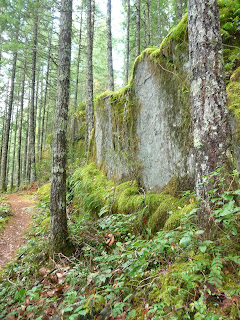
Boulder Garden Loop, Little Si, Old Si, Talus Trail (November 2009)
Time constraints and weather kept us from “finishing” any of the trails but we did venture far enough for photography and moderate exercise. These trails have been hiked sometime between November 7 and today, November 18.
The Boulder Garden trail is now signed again. The sign has been missing for a few years but those who knew about the trail could find it easily enough. The trail starts out on the Little Si trail in North Bend. Find the Boulder Garden trail within 1/8 of a mile or so along the Little Si trail. It’s a pretty trail, especially in the fall with a little bit of fall color still hanging in on the trees and shrubs. Spurs lead to viewpoints from mossy boulders down to North Bend, Rattlesnake Mountain and nearby foothills.
If you’re looking for the Old Si trail it is not signed but when you get to the high point there is another sign for the Boulder Garden trail with arrows pointing both ways. The Old Si trail heads uphill from there. The Old Si trail is steep, in places “rooty” and there are slick spots where wet leaves plaster the trail. We hiked about a half an hour before turning around.
Of course, if you’re doing the Boulder Garden loop continue on the loop (that part of the loop is actually a stretch of the Old Si trail).
We went part way up the Old Si trail but no one in my party felt like going to the top so we turned around and headed back to the Boulder Garden Loop. Rather than complete the loop and return to the car we headed for Little Si.
My companions did not know about the cliffs that are familiar to climbers and scramblers. However, that area is now posted with warning signs to stay on designated trails so if you venture into or onto the boulders/cliffs you have been warned – quite possibly you could get a fine for leaving the trail system. We admired the boulders from a discreet distance as I recalled past scrambles before such signs were posted.
After a look at the off-limits cliffs we retraced our route back to the car via the Little Si trail.
A few days prior I hiked the Talus Loop at Mount Si. The signs were missing for this loop but it’s easy enough to spot. Hopefully the hike is still “legit” because it’s a sweet little hike. I like the trail because it gives me a moderate workout without running into the crowds. Again, I enjoyed the last of the fall color (especially vine maple) and displays of mushrooms all along the seldom-hiked trail. There’s a nifty viewpoint along the trail from a boulder field, the boulder field bordered by vine maples and evergreens.
Time constraints and weather kept us from “finishing” any of the trails but we did venture far enough for photography and moderate exercise. These trails have been hiked sometime between November 7 and today, November 18.
The Boulder Garden trail is now signed again. The sign has been missing for a few years but those who knew about the trail could find it easily enough. The trail starts out on the Little Si trail in North Bend. Find the Boulder Garden trail within 1/8 of a mile or so along the Little Si trail. It’s a pretty trail, especially in the fall with a little bit of fall color still hanging in on the trees and shrubs. Spurs lead to viewpoints from mossy boulders down to North Bend, Rattlesnake Mountain and nearby foothills.
If you’re looking for the Old Si trail it is not signed but when you get to the high point there is another sign for the Boulder Garden trail with arrows pointing both ways. The Old Si trail heads uphill from there. The Old Si trail is steep, in places “rooty” and there are slick spots where wet leaves plaster the trail. We hiked about a half an hour before turning around.
Of course, if you’re doing the Boulder Garden loop continue on the loop (that part of the loop is actually a stretch of the Old Si trail).
We went part way up the Old Si trail but no one in my party felt like going to the top so we turned around and headed back to the Boulder Garden Loop. Rather than complete the loop and return to the car we headed for Little Si.
My companions did not know about the cliffs that are familiar to climbers and scramblers. However, that area is now posted with warning signs to stay on designated trails so if you venture into or onto the boulders/cliffs you have been warned – quite possibly you could get a fine for leaving the trail system. We admired the boulders from a discreet distance as I recalled past scrambles before such signs were posted.
After a look at the off-limits cliffs we retraced our route back to the car via the Little Si trail.
A few days prior I hiked the Talus Loop at Mount Si. The signs were missing for this loop but it’s easy enough to spot. Hopefully the hike is still “legit” because it’s a sweet little hike. I like the trail because it gives me a moderate workout without running into the crowds. Again, I enjoyed the last of the fall color (especially vine maple) and displays of mushrooms all along the seldom-hiked trail. There’s a nifty viewpoint along the trail from a boulder field, the boulder field bordered by vine maples and evergreens.






